THE CASE FOR HUNTING OP-ED
False sympathy will not help Namibia’s people or our elephants – it is anti-conservation
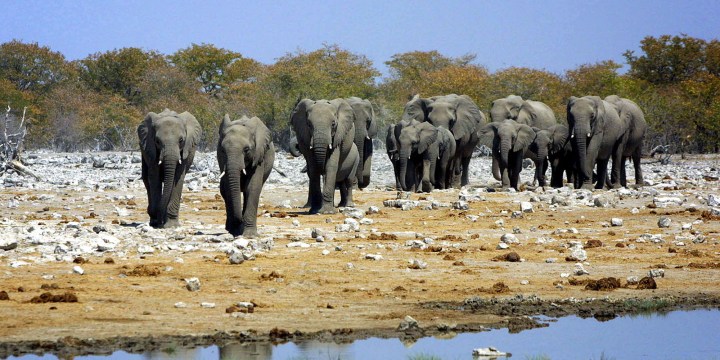
Animal rights groups are deliberately targeting Namibia’s community-based conservation model because it derives part of its income from trophy hunting. This is despite the model being hailed internationally as one of Africa and the world’s major conservation success stories.
Animal rights organisations seem to be strangely fixated on Namibia’s community conservation model. The reason is obvious: Namibia includes hunting as part of its broader wildlife economy and has made greater efforts to include rural communities in conservation than most other countries in the world. Recently rated second in the world (Botswana was first) for conserving “mega fauna” (large mammals) in a peer-reviewed scientific paper, Namibia’s strategy that includes the sustainable use of wildlife is clearly working, much to the annoyance of animal rights organisations.
It therefore came as no surprise when a coterie of such organisations – Animal Survival International, the Animal Welfare Institute, the Born Free Foundation, Fondation Franz Weber, Future for Elephants, Humane Society International and Pro Wildlife – funded a report on Namibian conservation, despite none of these organisations funding any real conservation work in the country.
Since animal rights positions are effectively countered by the success of human rights-based conservation, they specifically targeted the Community-Based Natural Resource Management (CBNRM) programme.
CBNRM was established in southern Africa during the 1980s and 1990s when several newly independent countries were looking for more inclusive conservation models than those practised by the colonial regimes. In Namibia, one of the major issues identified by rural communities was the discrepancy between wildlife ownership on freehold land (then held exclusively by white farmers) compared with communal land.
While freehold farmers were granted rights to use wildlife occurring on their land a few decades before independence (leading to impressive wildlife recoveries on these lands), people on communal lands were still locked out of the wildlife economy. With no incentive to conserve wildlife that was perceived as belonging to the government and white people only, poaching was rife and human-wildlife conflict went unchecked, which made some communities openly hostile towards conservation officials.
That all changed with an amendment to legislation in 1996, which allowed self-identified communities to apply for their lands to be gazetted as communal conservancies that they would manage following their own constitutions. This opened the door for people on communal lands to obtain similar rights to wildlife as freehold farmers, which soon resulted in wildlife populations increasing on land where it was formerly pushed to the brink of local extinction.
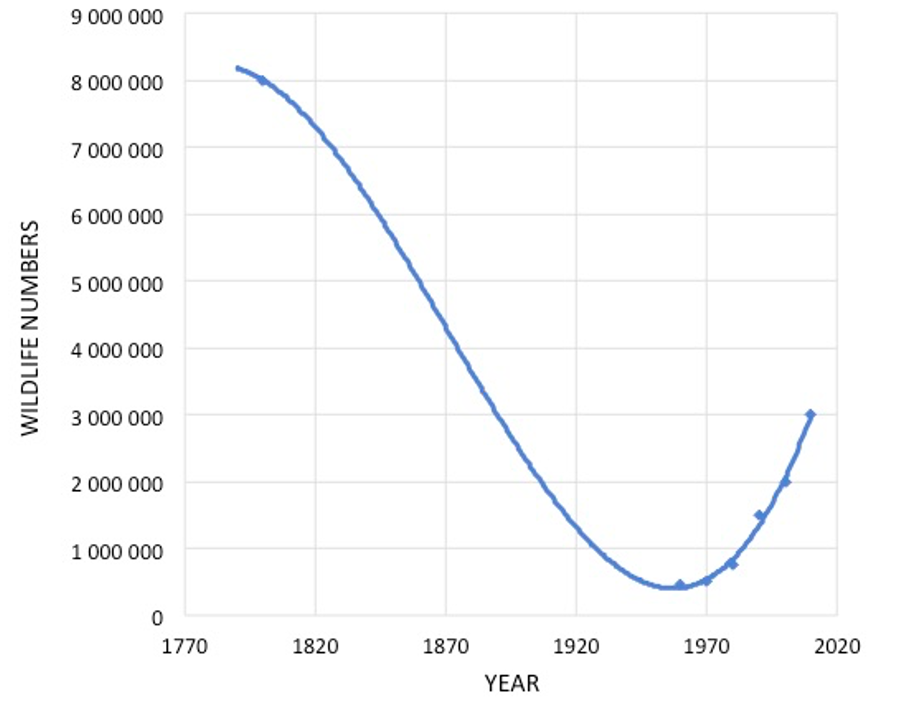
National wildlife trends in Namibia from an early rough estimate in the 1700s to today (more accurate data obtained since the mid-1900s). The turning point in the late 1960s came with changes to government policy allowing wildlife ownership on freehold land. (Source: Dr Chris Brown)
In practice, operating a communal conservancy is a complicated task, as these groups of people choose to work together to conserve their resources for the common benefit. Further, the wildlife species that live on these lands are notoriously difficult to live with – elephant, lion, crocodile and hippopotamus occasionally take human lives, while these and other species (such as spotted hyena, leopard, cheetah and African wild dog) frequently threaten livelihoods by destroying crops and killing livestock.
Communal conservancies are unfenced, which on the one hand makes them particularly useful as wildlife corridors but on the other introduces the difficulty of keeping unwanted visitors or illegal settlers out. Finally, these community institutions are nested within a larger socioeconomic and ecological landscape that inevitably affects their operations and the lives of their members.
Journalists Adam Cruise and Izzy Sasada use the complexity of CBNRM and broader societal issues that have little or nothing to do with CBNRM to create a thin veil of feigned concern for people and wildlife that does little to conceal their main objective – to attack trophy hunting.
Cruise is on record comparing the sustainable use of wildlife for the benefit of people to parasitism, where humans are the “parasite” and nature is the “victim”. Their report, reported on by Daily Maverick on 14 December 2021, would never pass any form of peer review due to its almost information-free methods section. Besides that, there are obvious conflicts of interest relating to funding and the lead author has previously expressed extreme bias against the object of investigation – African communities using their natural resources for their benefit.
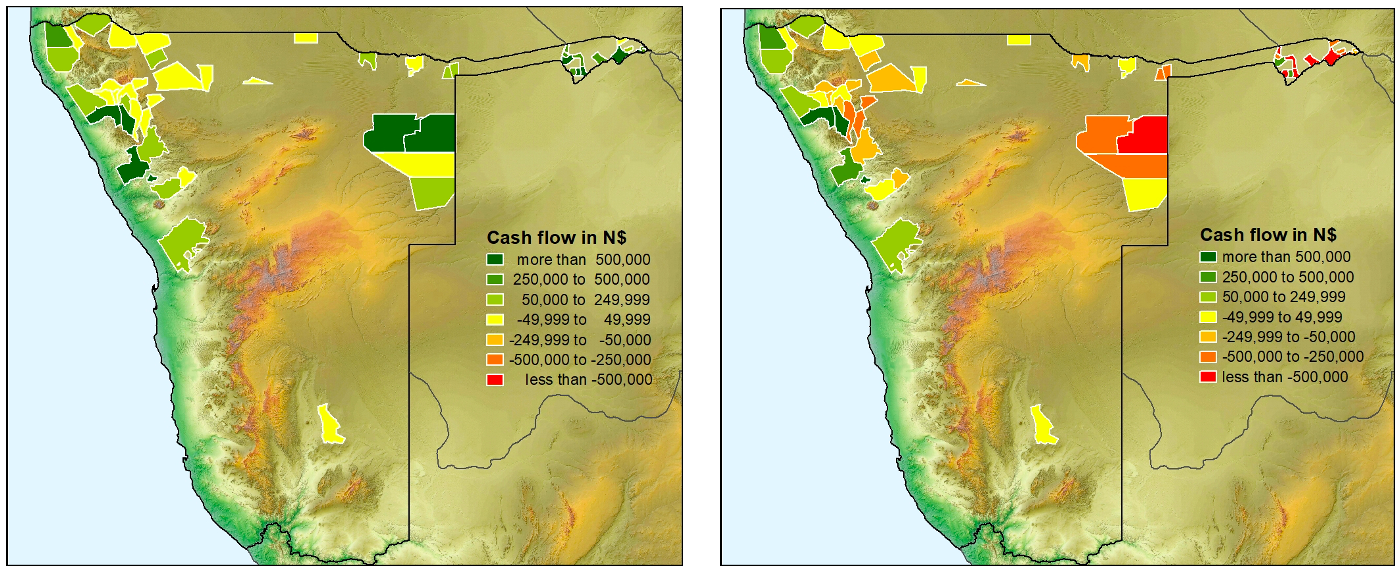
Cash flow in conservancies in 2019 with income from tourism and hunting (left). Cash flow in the same conservancies without income from hunting (right). The removal of hunting income would push most conservancies in the northeast into the red, particularly in the Zambezi Region. Conservancies for which there was either no income or no data for that year are not shown. (Source: MEFT and NACSO (2021) The State of Community Conservation in Namibia (2019 Annual Report)).
Regarding the methodology, nothing is said of the total interview sample size, how interviewees were selected or what kind of questions they were asked. There is no mention of obtaining free, prior and informed consent from interviewees, or of any ethical clearance or research permits received prior to this fieldwork.
Omissions of this nature are not permitted in scientific literature, because they are easily used to hide interviewer bias and unethical procedures. By publishing this report without any of the relevant information described above, the interviewers effectively sidestepped all ethical requirements or the need for scientific rigour. In order to work in Namibia, foreigners must apply for permits from the Ministry of Home Affairs and Immigration, while research permits must be obtained from the National Commission on Research, Science and Technology. Conducting fieldwork and social research without such permits is illegal in Namibia.
Meanwhile, the “on-site assessment” of issues relating to elephants appears to have been based on drive-by observations lasting a few weeks in each of the regions they investigated. These random observations are then used throughout the report to cast doubt on data collected through well-established scientific methods (such as aerial surveys), extensive government consultations regarding human-elephant conflict, and long-term data collected by the conservancies.
Elephant sightings from the ground, gathered without systematic methodology, inevitably underestimate elephant population numbers, which is why aerial surveys (and counts of individually identifiable elephants, where possible) are used to generate more accurate estimates in Namibia and elsewhere in Africa.
Yet Cruise emphasises casual drive-by observations or elephant sightings recorded by the conservancies from ground-based counts, thus implying that these are more accurate than systematically collected data.
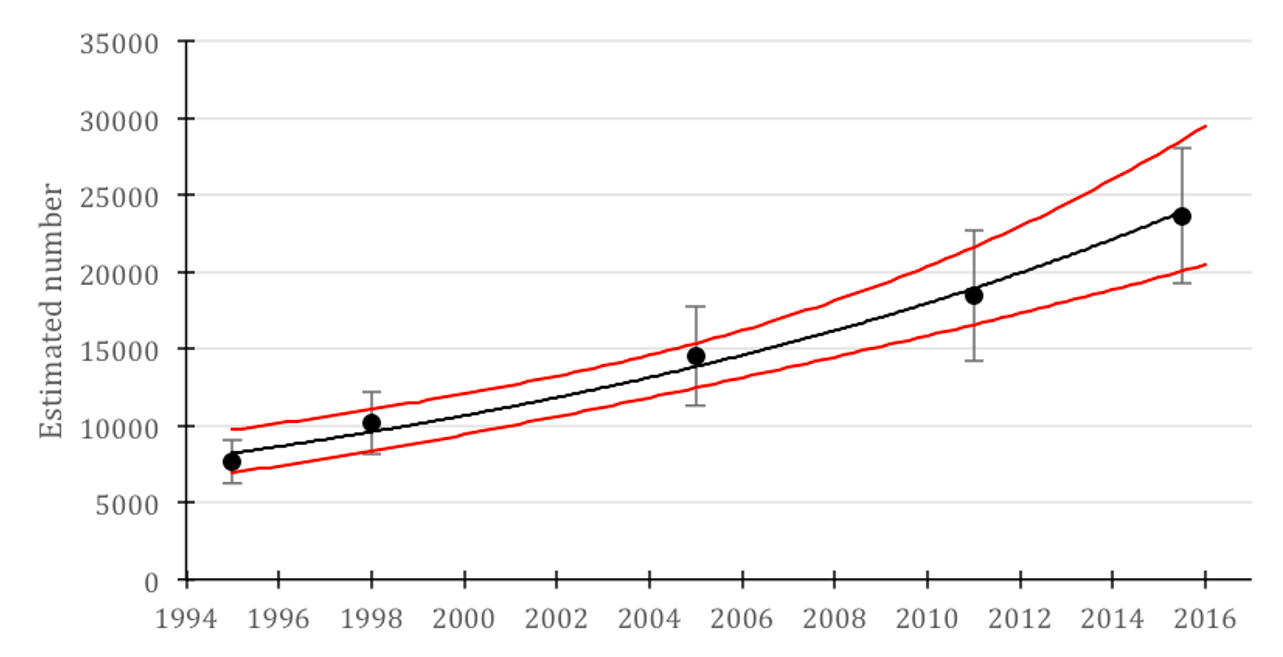
Elephant population trend in Namibia based on data collected using systematic, scientific methods. (Source: MEFT (2020) Draft Elephant Management Plan)
Cruise and Sasada’s initial description of the economic benefits of trophy hunting is a telling glimpse of the bias that runs throughout the report. Comparing the contribution to the GDP from a niche sub-sector of tourism that requires free-roaming large mammals (hunting) with that of tourism in general is disingenuous. The entire tourism industry includes hotels, beach resorts, scenic tours, etc that do not require any wildlife to be present; most of this tourism revenue accrues to urban areas. Dividing hunting income by land surface area is even more bizarre, especially for a huge desert country such as Namibia – hunting income is not used to cover every hectare of the country in money.
More relevant statistics that focus on the relative contributions of these two industries to communal conservancies reveal that hunting (which includes trophy and meat hunting) contributed 30% of the total revenues generated by communal conservancies, while tourism contributed 66% in 2019. Additionally, many conservancies rely solely on revenue generated through hunting for their income.
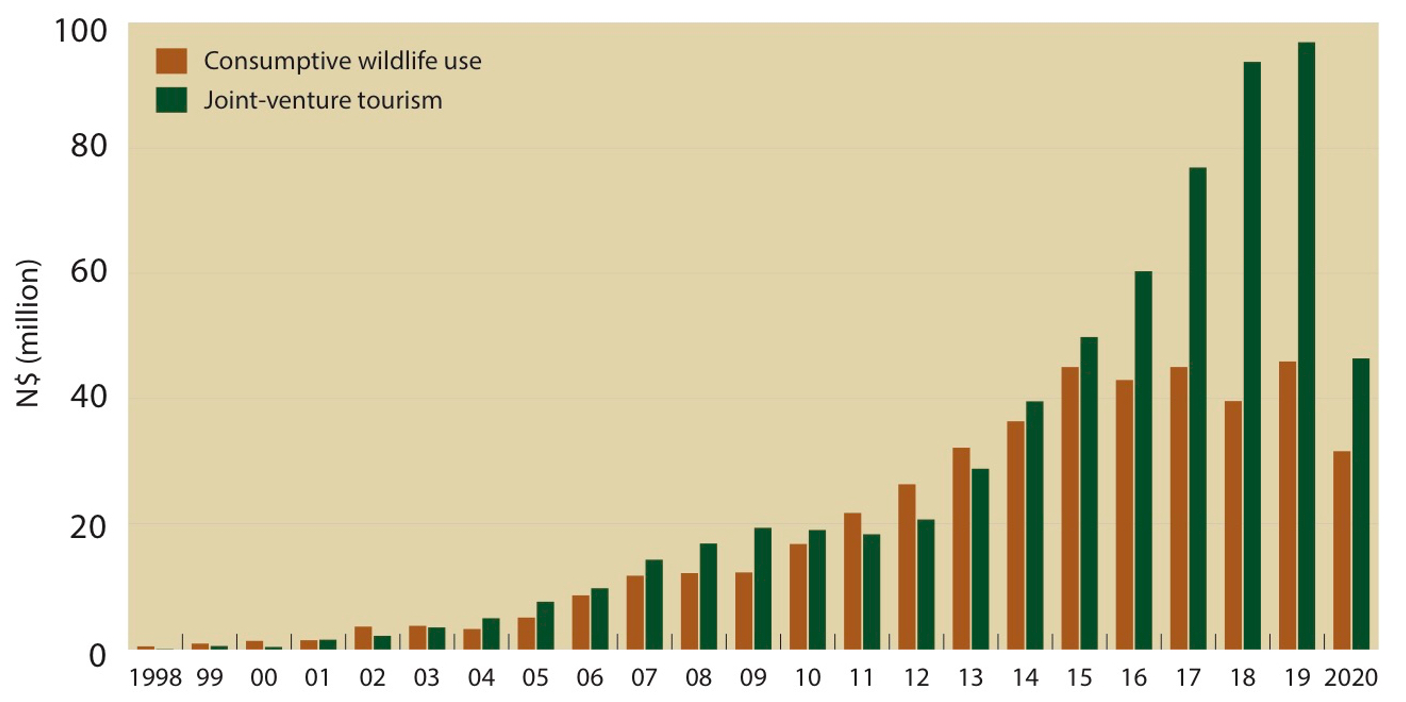
Income from all forms of consumptive wildlife use (includes the value of meat distributed and fees from trophy hunters) and joint-venture tourism (includes employment of conservancy members). The impact of Covid-19 was greater on tourism in 2020 than it was on hunting. (Source: MEFT and NACSO (in press). The State of Community Conservation in Namibia (2020 Annual Report))
The authors’ other biases are visible in their treatment of conservancies located in three different regions of the country – Kunene, Otjozondjupa and Zambezi. In the Kunene Region, which has suffered a severe, prolonged drought in recent years, the focus is on wildlife declines. Drought is the ultimate cause behind both the wildlife declines and the increased poverty they reported among Himba people (who lost most of their livestock due to drought), yet it is barely mentioned.
Cruise, the journalist who tackled the “elephant ecology” part of the report, fails to explain that wildlife migrate extensively and/or die off during times of drought, only to return and reproduce quickly when conditions are favourable. His random observations at the end of a long drought period are therefore not an accurate portrayal of wildlife trends since the start of CBNRM (these trends are publicly available here).
He also appears to be unaware that these arid areas are at the extreme margin of elephant range (even without conflict with people), making this sub-population particularly vulnerable to drought. This situation further exacerbates conflict with farmers, which led to the Ministry of Environment, Forestry and Tourism (MEFT) taking steps to reduce elephant numbers in the eastern parts of the Kunene Region through a live elephant auction.
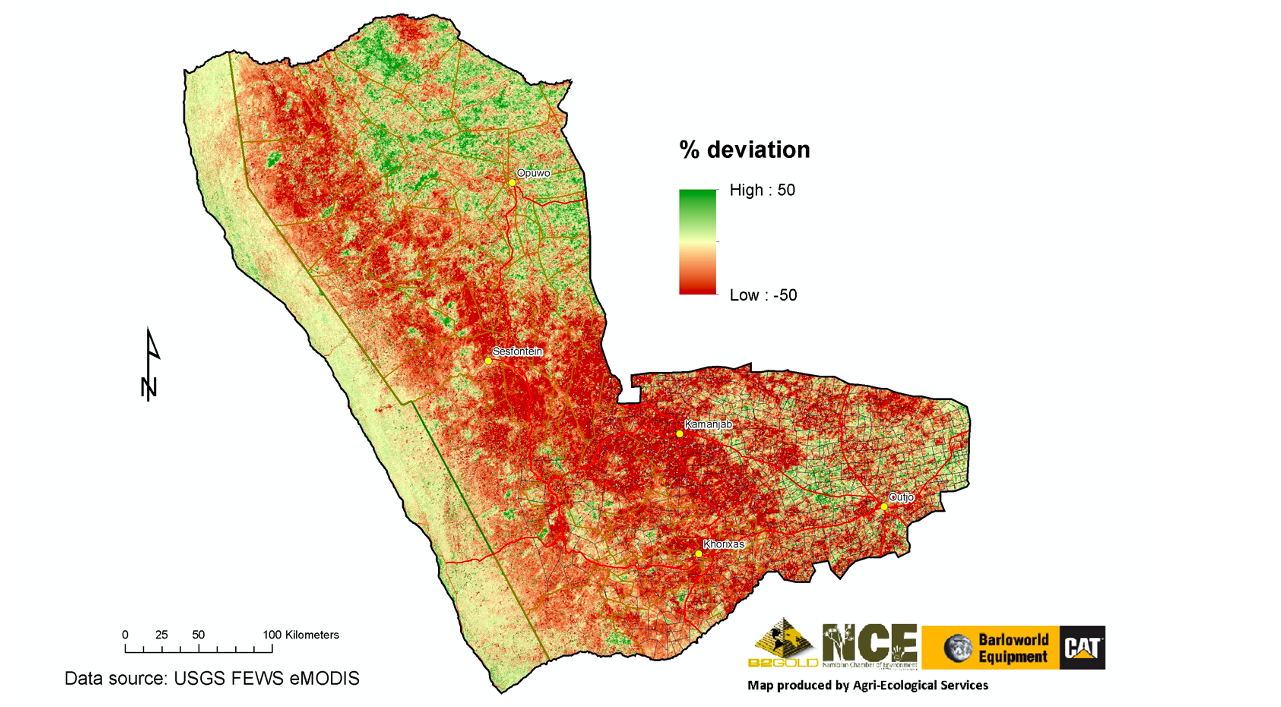
The state of vegetation in the Kunene Region in May 2021 at the time of Cruise and Sasada’s visit (darker red = further below-average vegetation growth; darker green = further above-average growth; yellow is close to average). While some parts of the region received better rainfall at the start of this season, the 10-year drought continues unabated in many areas. (Source: namibianrangelands.com)
In eastern Otjozondjupa, where elephant populations are healthy and increasing, Cruise and Sasada shift the focus from wildlife management to marginalised rural communities. Similar to other journalists who have dropped in to interview these communities with false sympathy for their plight, they present the many socioeconomic challenges faced by San people today, most of which have little or nothing to do with CBNRM. Everything from alcoholism to the price of food at local shops is described in detail, while even conservancies are cast as some form of oppression.
The uninformed reader might be led to believe (deliberately, it seems) that the government appoints committees to manage these conservancies, yet this is not true. Conservancy management committees are elected by their own communities following democratic processes. One of the CBNRM-related complaints from this region was the inequitable distribution of meat – interviewees clearly wanted more meat more frequently. One wonders if the interviewer revealed that their ultimate goal was to cut off the game meat supply to these communities entirely?

Four conservancies compared in terms of their sources of returns (data from 2018). Nyae Nyae Conservancy, which is one of two conservancies that were investigated in Otjozondjupa, relies most heavily on hunting-related income and meat. Without this income, Nyae Nyae would not be able to function or distribute any meat to its members. Salambala is in the Zambezi Region, while Torra and ≠Khoadi //Hôas are in the Kunene Region. (Source: MEFT and NACSO (2020) The State of Community Conservation in Namibia (2018 Annual Report))
The third region – Zambezi (formerly Caprivi) – also has healthy wildlife populations and the journalists quote fewer people in this section compared with the other sections (which leaves open the possibility that most of the responses they received were not to their liking). They therefore shift their focus once more to include the failed secession attempt by some Caprivians in 1999 (what that has to do with CBNRM remains unclear), plus human-elephant conflict that is a real challenge in an environment where both human and elephant densities are high. The Zambezi Region is home to more than 90,000 people and is located in the centre of the larger Kavango-Zambezi Transfrontier Conservation Area that supports an estimated 220,000 elephants.
A common complaint reported both here and in the other regions was that not enough money is provided through the government’s conflict offset scheme (which is topped up by conservancies). What Cruise and Sasada fail to mention to their readers is that the current scheme would not exist without funds generated from the sustainable use of wildlife (via the Game Products Trust Fund).
What they failed to mention to their interviewees is even more egregious – that their ultimate desire is to eliminate the current source of funding for human-wildlife conflict offsets entirely.

Expenditure by the Game Products Trust Fund (GPTF) in Namibian dollars for the period 2012-2018 – N$16.7-million was spent on human-wildlife conflict. All of this revenue is derived from the sustainable use of wildlife – both hunting and live sales income that the government receives. (Data used with permission from the GPTF)
Taken as a whole, this report looks distinctly like a “hit-and-run” job aimed at trophy hunting, with community conservation as a secondary casualty. Now that the interviews are over, perhaps the authors would like to return to Namibia to present their results to their interviewees – with honest conclusions and detailed consequences of their recommendations. An honest presentation would include the following points:
- You (interviewees) wanted more meat and other benefits from your conservancy; we want your conservancy to stop the sustainable use of wildlife, which means there will be no more meat to distribute, while other benefits will similarly decline in future;
- You desired more money to offset the costs of living with wildlife; we want the current source of funding (sustainable wildlife use) for the offset scheme to be eliminated, thus leaving you with no offset scheme at all; and
- You complained about people who come in from outside and settle on your land illegally; we would like to further weaken the grassroots institutions in your region (conservancies) that have fought legal battles for your cause.
Unfortunately, expecting such an honest report is unrealistic, since the whole investigative process was done in bad faith. Having spoken to an interviewee quoted in this report, we know that the journalists did not introduce themselves as such and obtained no consent whatsoever to use any of the quotes they obtained. The people who provided their honest, off-hand opinions to a passing stranger would have had no idea that their words would be used against them – to worsen their current situation.
The journalists and their financiers will no doubt use this illegal and unethical report to further their animal rights agenda, while not spending a dollar of their lobbying budgets to alleviate the plight of the people left in their wake.
In fact, a worse situation for both people and animals would prevail if their dream of dismantling community conservation came true. More than 1,000 people who are directly employed by conservancies will lose their jobs, the meat currently being distributed will no longer be available, and the voices of marginalised rural communities will be silenced.
For the animals, poaching and the associated illegal wildlife trade will skyrocket in the absence of community game guards, entirely unchecked human-wildlife conflict will result in more deaths (of wild animals, livestock and people), and the wildlife corridors in the Zambezi Region will be effectively closed by agriculture.
The difficulties faced by rural Namibians and reflected in this report are real, yet CBNRM has never been presented as the silver bullet that would fix every problem in society. As it stands, this democratic system of wildlife management is not perfect and solutions to the multiple challenges that conservancies face are far from simple. If Covid-19 has taught us anything, however, it is that everything becomes much more difficult when income from wildlife-based industries is summarily cut off.
The ultimate goal of this report – to effectively remove 30% of all conservancy revenues, and 100% of revenues for hunting-reliant conservancies – should therefore be treated like a viral infection that would greatly weaken Namibia’s conservation efforts. DM
This article is supported by the following institutions: 69 members of the Namibian Chamber of Environment (NCE); The Ministry of Environment, Forestry and Tourism (MEFT); The Namibian Association of CBNRM Support Organisations (NACSO).



















 Become an Insider
Become an Insider
A well reasoned response to a report that can only be described as a “drive-by shooting”.
Wildlife management is a really difficult thing to do when the animals are dangerous and obviously wild! The report needs to be seen as “click-bait” for a funding drive by organisations that have no skin in the game.
The report degrades science and the scientific method to a point where armchair researchers start to challenge real science in a quest to publish.
Brilliant and much-needed response by affected communities and conservationists in Namibia to an unethical and biased piece of “research”. As a DM Insider I’m glad to see grassroots and local voices amplified. The funders of the report would do well to distance themselves and not use it to further their anti-wildlife use and anti-community beneficiation objectives. Requests for the TORs, research design and instrument, and ethical clearance have fallen on deaf ears. One can only surmise that such crucial research documents don’t exist or this was agenda-driven “research” aimed at smearing community conservation in Namibia. The end does not justify the means in this case. Parachute research of this nature affects the work by others who do meaningful work with communities to improve livelihoods and biodiversity conservation.